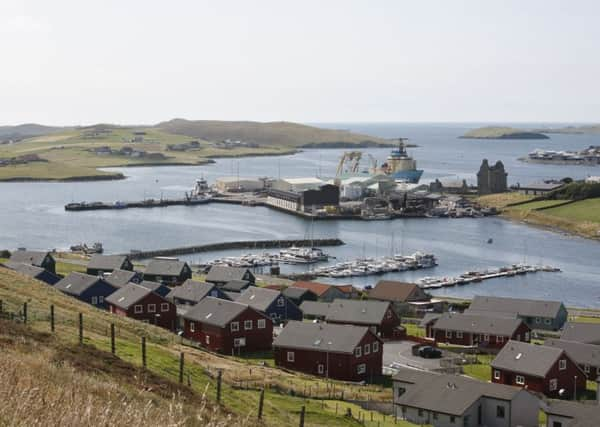Travel review: The Shetlands


The travel trade calls them “set-jetters” – people who visit places used as film and TV locations. Over the past few years, plenty of them have been heading north (very north) to Shetland on the trail of murder.
Inspired by Shetland, the crime series filmed partly on the islands, they search for the home of Jimmy Perez, the dogged detective hero, and the places where murderers hid or bodies were found.
Advertisement
Hide AdAdvertisement
Hide Ad“Shetland has always had a lot of exposure for its natural history, but the series has taken it to a whole new audience,” says Steve Mathieson, Shetland’s island manager for VisitScotland, when we meet on a very windy day in the capital, Lerwick.
Fair enough, but does portraying the islands – on the same latitude as St Petersburg and Oslo – as cold, dark, brooding, unrelentingly bleak and harbouring more than their fair share of homicidal psychopaths do much for their image?
“We credit the BBC audience with the capacity to differentiate between reality and the fiction which is there for dramatic effect,” says Mathieson. “If people took The Shetland Times, they wouldn’t be reading about murders every week. We’re probably one of the safest places in Britain to live. The drama is in the landscape and the weather.”
Ah yes, the weather... the last-but-one of our half-dozen visits to Shetland was a commission to write about midwinter storm-watching, an offbeat hobby that started out in the US. Enthusiasts research wild weather, head to its epicentre and, provided they’re not blown away, love every minute of it.
Advertisement
Hide AdAdvertisement
Hide AdPersonally, I think there’s a lot to be said for quiet woodland strolls, but no matter. We chose a weekend at random and, with uncanny instinct, it coincided with Shetland’s strongest winds for 20 years, Storm Force 12, gusts of 105mph. Mission accomplished.
As we crossed the car park at Sumburgh Head lighthouse, one of Shetland’s most exposed spots, we had to link arms with another couple to avoid being swept off our feet. It was like being whacked across the chest with a large shovel.
So: Shetland fans and storm-watchers, this is absolutely the place for you. What, though, if you’re neither? What else does Shetland have to offer? Plenty... the cliffs (the ones at Eshaness are spectacular), whale sightings, the abundant birdlife (6,000 puffins perching on one cliff; skylarks and curlews chorusing in summer) and the archaeology.
Shetland boasts more prehistoric sites than any other British area of comparable size. The most famous of them is Jarlshof, a 4,000-year-old settlement exposed by a 19th century storm. It’s a sometimes puzzling mosaic of walls, including the first Viking longhouses discovered in Britain.
Advertisement
Hide AdAdvertisement
Hide AdUntil the 15th century the islands were ruled by Norway and they still feel like a far outpost of Scandinavia. This Viking legacy is celebrated every year in late January with Up Helly Aa, Europe’s biggest fire festival.
Crowds of men with hyper-hipster beards and flamboyant helmets parade through the streets of Lerwick carrying flaming torches, and set fire to a specially built Viking longboat. Then they raise a glass or two.
It’s a good time to see Shetland at its most elemental. As Ann Cleeves, whose crime novels inspired the TV series, has said: “It’s wild and awe-inspiring... I love the drama of dark midwinter days, the contrast of the wild weather outside and the warmth indoors, peat fires and gossip, the click of knitting needles or the hum of a spinning wheel.”
On our most recent Shetland trip, we’re there a few weeks before the celebrated “simmer dim”, the prolonged midsummer twilight when – magically but potentially sleeplessly – it’s still light enough at midnight to read an Ann Cleeves novel outside.
Advertisement
Hide AdAdvertisement
Hide AdFrom the airport, we drive to our hotel – Busta House, a welcoming country house dating back to the 16th century – along the road that sweeps up Shetland’s main island. It crosses wild moorland landscape dotted with lochs and roamed by sheep and ponies. The sky is overcast and the moors look gloweringly grey and forbidding. Not a good start.
It’s all change next morning, though. The moors are bathed in sunshine and glow a warm brown. A soft blue sheen slowly settles on them.
In Lerwick, which has a Brothers Grimm-ish atmosphere, we head straight for the stylish modern Shetland Museum, which offers a vivid insight into the islands’ life and culture. There are Viking combs, a 17th century felt hat, an 18th century wig-stretcher and a 1940s motorcyclist’s leather helmet – just to mention head-related things.
Lerwick took over in 1708 as capital from Scalloway, a coastal village of brightly painted stone cottages and sharply gabled houses that could have been shipped here from Norway. It’s the home of the Scalloway Hotel, a smart, convivial place with an excellent restaurant. Guests have included Princess Anne and David Cameron (not together) – and Douglas Henshall, who plays Jimmy Perez.
Advertisement
Hide AdAdvertisement
Hide AdShetland also boasts Britain’s most northerly fish and chip shop and Indian restaurant. Remember this for pub quizzes. And keep a keen eye on the weather forecasts.
GETTING THERE
McKinlay Kidd (0141 308 8009 / www.mckinlaykidd.com) has a six-night Shetland fly-drive break from £935 per person (two sharing). It includes flights to Shetland from Aberdeen, Edinburgh or Glasgow, six nights’ hotel accommodation (B&B), car hire on Shetland and a guided boat trip around the island of Noss, famous for its bird reserve.